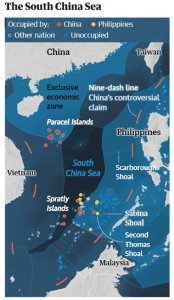TAG: GS 2: INTERNATIONAL RELATIONS
THE CONTEXT: Recently, a confrontation between Chinese and Philippine vessels near the disputed Sabina Shoal in the South China Sea escalated into a collision.
EXPLANATION:
- Both nations have been engaged in a series of confrontations in this region, with the latest incident being the most recent and serious of these encounters.
- The collision has led to a heated exchange of accusations between Beijing and Manila.
- The Chinese Coast Guard spokesperson claimed that a Philippine vessel deliberately collided with a Chinese ship.
- According to the spokesperson, the incident occurred when the Philippine vessel “illegally entered” waters near Xianbin Reef, part of the Nansha Islands, without Beijing’s permission.
- He insisted that the Chinese coast guard had taken “control measures” in response to this perceived intrusion.
- On the other hand, Manila’s National Task Force on the West Philippine Sea provided a different account, stating that the collision was a result of “unlawful and aggressive maneuvers” by the Chinese vessels.
- Two Philippine Coast Guard ships, BRP Cape Engano and BRP Bagacay, were damaged during the incident.
- Manila claims that the Chinese vessels acted aggressively, leading to the structural damage of their ships.
Location and Strategic Importance of Sabina Shoal
- The Sabina Shoal, located approximately 140 kilometers west of the Philippine island of Palawan, is a crucial area in the South China Sea.
- Although it lies over 1,000 kilometers from China’s nearest major landmass, Hainan Island, Beijing claims sovereignty over it, referring to it by its Chinese name, Xianbin Reef.
- This shoal’s strategic position makes it a significant point of contention between the two countries.
- The Philippines fears that China may be attempting to establish an artificial island on the Sabina Shoal, similar to other constructions in the South China Sea.
- Both nations have stationed coast guard vessels around the shoal in recent months, heightening tensions and the potential for conflict.

Broader Implications and Historical Context
- The repeated confrontations in the South China Sea, particularly near disputed areas like Sabina Shoal, have raised concerns about the potential for a broader conflict.
- The United States, as an ally of the Philippines, could be drawn into such a conflict if tensions escalate further.
- Analysts suggest that China’s actions may be part of a broader strategy to assert control over the Sabina Shoal by pushing outwards from the nearby Second Thomas Shoal.
- This would effectively encroach on the Philippines’ exclusive economic zone and normalize Chinese dominance in the region.
- The current situation bears similarities to the events of 2012, when China took control of the Scarborough Shoal, another strategic area in the South China Sea close to the Philippines.
- The parallels between these two incidents highlight the ongoing struggle for dominance in the South China Sea, with both regional and global implications.

